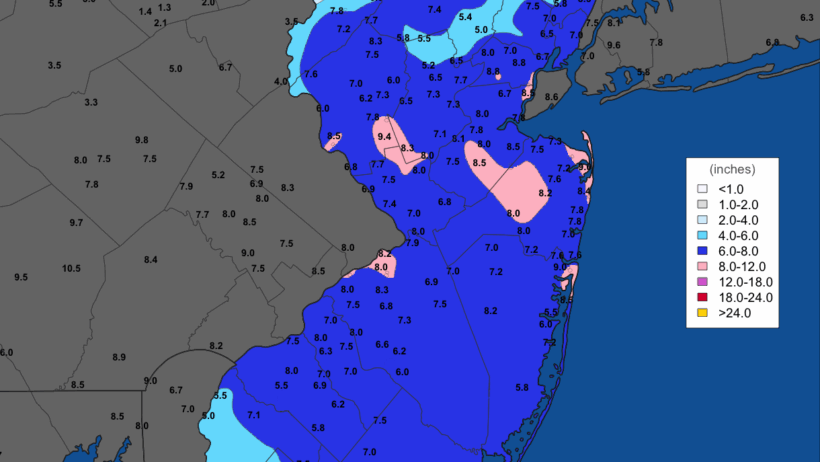New Jersey, located in the northeastern United States, is often characterized by its geographical diversity, which profoundly influences its climate. This state experiences a moderate climate with four distinct seasons, ranging from sultry summers to frigid winters. The interaction of the Atlantic Ocean and the Appalachian Mountains creates a unique meteorological environment that contributes to the state’s climate complexity.
Beginning with summer, New Jersey can become a bastion of warmth and humidity. From June to August, temperatures typically soar into the upper 80s°F (around 30°C) and can occasionally approach the 90s°F. Coastal areas experience a cooling effect from oceanic breezes, whereas inland regions may feel stifling heat. As a result, beachgoers flock to the picturesque shorelines, seeking respite from the fiery sun, while farmers and gardeners relish the growing season’s vibrancy. Yet, summer is not without its challenges; thunderstorms frequently brew, occasionally escalating into severe weather, with heavy rains and wind gusts that pose risks to life and property.
Autumn ushers in a transformation both visually and climatically. From September to November, New Jersey dazzles with foliage in vibrant hues of crimson, gold, and umber. Temperatures gradually decline, creating a comfortable milieu with daytime averages ranging from the mid-60s°F to low 70s°F. The crisp air, punctuated by the scent of fallen leaves, is a seasonal hallmark. However, this season also marks the onset of increased storm activity, as tropical storms may venture up the Eastern Seaboard, impacting the state with strong winds and heavy rainfall.
Winter significantly alters the state’s visage. New Jersey is no stranger to snowstorms, particularly in January and February when temperatures can plummet into the teens°F (-10°C) during nights. Snow can blanket both urban and rural landscapes, transforming them into picturesque winter wonderlands. The average snowfall varies greatly depending on proximity to the coast; coastal regions may receive less accumulation compared to the northwestern part of the state. The meteorological phenomenon known as Nor’easters can deliver copious amounts of snow, often resulting in transportation disruptions and necessitating robust snow removal strategies. These winter storms, while often a source of frustration, play a pivotal role in replenishing groundwater and contributing to ecosystem vitality.
As winter falters and gives way to spring, the climate experiences yet another metamorphosis. March through May brings a renaissance of life, with budding flora and revitalized fauna. Temperatures begin to rise, averaging from the mid-40s°F in early March to the mid-70s°F by late May. This transitional period sees the erratic behavior of New Jersey weather; days of balmy warmth can just as easily be interspersed with sudden chills and unexpected frost. The variability can be attributed to the lingering effects of winter, the warming influence of advancing spring, and the moisture-laden air masses sweeping up from the Gulf of Mexico.
The diverse landscape of New Jersey further accentuates its climatic variations. The state comprises coastal plains, rolling hills, and mountainous regions, each region bearing its climatic signature. The northern highlands experience cooler temperatures and higher snowfall, while the southern and southeastern portions are generally milder, buffered by proximity to the Atlantic Ocean. Furthermore, urbanization has introduced a phenomenon known as the urban heat island effect, where developed areas exhibit higher temperatures than surrounding rural locales, a concern for public health and environmental quality.
Climate change also poses significant challenges for New Jersey. Rising sea levels threaten coastal communities, while shifts in weather patterns could increase the frequency and intensity of extreme weather events. These alterations demand an urgent response from residents and policymakers alike, invoking the need for sustainable development practices and climate adaptation strategies. The ramifications of global warming are not merely abstract predictions; they are becoming palpable realities observed in shifting seasons, altered precipitation patterns, and increased storm intensity.
Engaging with New Jersey’s climate can evoke a deeper appreciation for nature’s intricacies. The beauty of a snow-laden landscape, the vibrant fall foliage, or the serenity of a summer evening by the shore serve as reminders of the interconnectedness of ecosystems and the indispensable role of human stewardship. A holistic understanding of the climate fosters a resonance with the environment, igniting passions for conservation, resilience, and sustainable practices.
In conclusion, New Jersey’s climate is a vivid tapestry woven from the threads of geography, seasonal diversity, and human impact. Its dynamic weather patterns conjure fascination, offering experiences that shape both the natural world and human existence. As the state grapples with the realities of climate change, the imperative for awareness and action becomes ever more pressing. Understanding the complexities of New Jersey’s climatic narrative not only enriches knowledge but also fosters a collective responsibility toward preserving the environment for future generations. The state’s weather patterns tell a story of resilience, challenge, and the enchanting rhythms of nature—an ode to the ever-changing climate that surrounds us.








